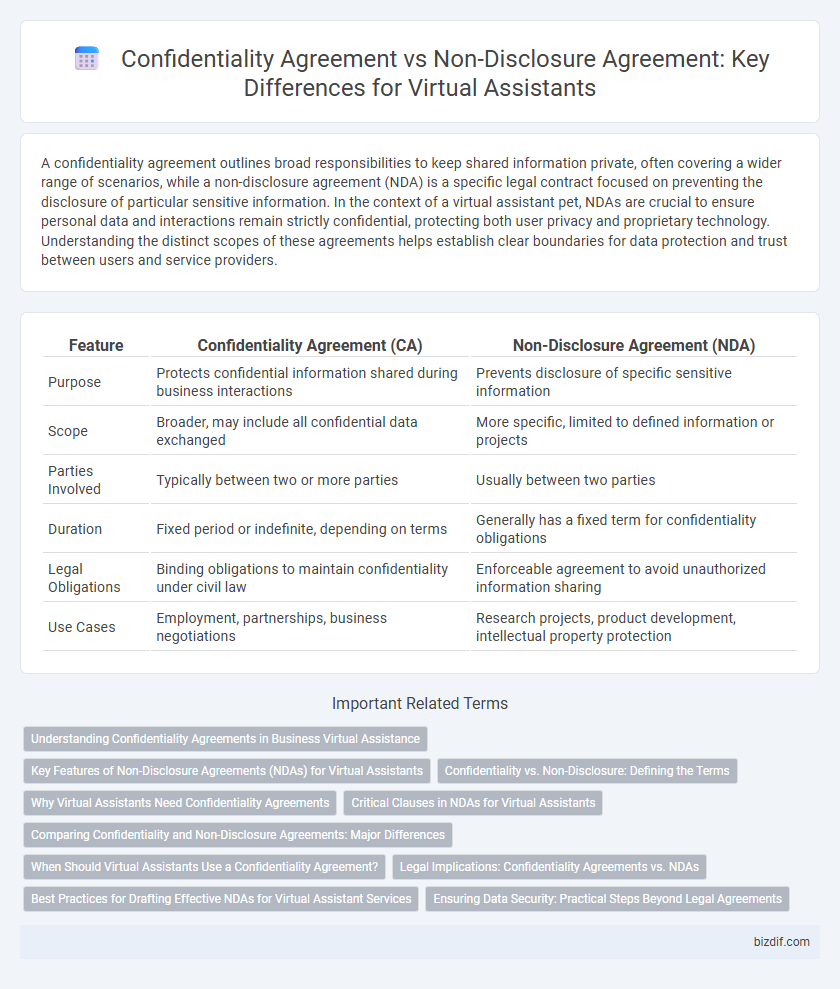A confidentiality agreement outlines broad responsibilities to keep shared information private, often covering a wider range of scenarios, while a non-disclosure agreement (NDA) is a specific legal contract focused on preventing the disclosure of particular sensitive information. In the context of a virtual assistant pet, NDAs are crucial to ensure personal data and interactions remain strictly confidential, protecting both user privacy and proprietary technology. Understanding the distinct scopes of these agreements helps establish clear boundaries for data protection and trust between users and service providers.
Table of Comparison
| Feature | Confidentiality Agreement (CA) | Non-Disclosure Agreement (NDA) |
|---|---|---|
| Purpose | Protects confidential information shared during business interactions | Prevents disclosure of specific sensitive information |
| Scope | Broader, may include all confidential data exchanged | More specific, limited to defined information or projects |
| Parties Involved | Typically between two or more parties | Usually between two parties |
| Duration | Fixed period or indefinite, depending on terms | Generally has a fixed term for confidentiality obligations |
| Legal Obligations | Binding obligations to maintain confidentiality under civil law | Enforceable agreement to avoid unauthorized information sharing |
| Use Cases | Employment, partnerships, business negotiations | Research projects, product development, intellectual property protection |
Understanding Confidentiality Agreements in Business Virtual Assistance
Confidentiality agreements in business virtual assistance are legal contracts designed to protect sensitive client information from unauthorized disclosure. These agreements ensure virtual assistants maintain strict privacy standards while handling proprietary data, trade secrets, and personal details. Unlike non-disclosure agreements (NDAs), confidentiality agreements often encompass broader terms related to ongoing data protection and responsibility throughout the service period.
Key Features of Non-Disclosure Agreements (NDAs) for Virtual Assistants
Non-Disclosure Agreements (NDAs) for virtual assistants specifically safeguard sensitive client information by legally binding the assistant to confidentiality, preventing unauthorized disclosure of proprietary data. Key features include clear definitions of confidential materials, explicit obligations to maintain secrecy, and specified timeframes for nondisclosure that often extend beyond the duration of the working relationship. NDAs also outline consequences for breaches, ensuring virtual assistants understand the critical importance of protecting client privacy and business secrets during and after their engagement.
Confidentiality vs. Non-Disclosure: Defining the Terms
Confidentiality agreements focus on protecting sensitive information shared between parties during ongoing collaboration, ensuring that private data remains secure and is used only for agreed purposes. Non-disclosure agreements (NDAs) specifically restrict the unauthorized sharing or public disclosure of proprietary or confidential information, often during preliminary discussions or negotiations. Understanding the distinction helps businesses select the appropriate legal framework to safeguard trade secrets and maintain trust in virtual assistant engagements.
Why Virtual Assistants Need Confidentiality Agreements
Virtual assistants handle sensitive client information daily, making confidentiality agreements essential to protect business secrets and personal data. Unlike general non-disclosure agreements, confidentiality agreements specifically outline the virtual assistant's obligation to safeguard client information across all communication channels. Implementing these agreements ensures trust, legal protection, and compliance with data privacy regulations, which are critical for maintaining client relationships.
Critical Clauses in NDAs for Virtual Assistants
Critical clauses in Non-disclosure Agreements (NDAs) for virtual assistants include the definition of confidential information, scope of confidentiality, and duration of the agreement, ensuring sensitive client data remains protected. Clauses specifying data handling protocols, permitted disclosures, and penalties for breaches are essential to maintaining trust and safeguarding business operations. Virtual assistants must carefully review these provisions to align with their responsibilities and client expectations.
Comparing Confidentiality and Non-Disclosure Agreements: Major Differences
Confidentiality agreements and non-disclosure agreements (NDAs) both protect sensitive information, but confidentiality agreements often cover a broader scope, including ongoing obligations during and after a business relationship. NDAs primarily focus on preventing the disclosure of specific proprietary information within a defined timeframe. Understanding the differences in scope, duration, and enforceability is crucial for virtual assistants managing client data and communication.
When Should Virtual Assistants Use a Confidentiality Agreement?
Virtual assistants should use a confidentiality agreement when handling sensitive client information such as personal data, business strategies, or proprietary processes to ensure legal protection and trust. This agreement outlines specific expectations and responsibilities regarding data privacy, preventing unauthorized disclosure during and after the working relationship. Implementing confidentiality agreements helps virtual assistants maintain professional integrity and safeguard client confidentiality in various remote collaboration scenarios.
Legal Implications: Confidentiality Agreements vs. NDAs
Confidentiality agreements and non-disclosure agreements (NDAs) both serve to protect sensitive information, but differ in scope and legal enforceability; confidentiality agreements often cover broader business relationships, while NDAs specifically restrict disclosure of proprietary data. Legal implications include potential breach consequences, with NDAs typically providing clearer terms for remedies and enforcement in case of unauthorized information sharing. Understanding these distinctions is critical for virtual assistants handling client data to ensure compliance and mitigate legal risks.
Best Practices for Drafting Effective NDAs for Virtual Assistant Services
When drafting Non-disclosure Agreements (NDAs) for virtual assistant services, clearly define confidential information and specify the obligations for both parties to ensure protection of sensitive client data. Include precise terms on data usage, duration of confidentiality, and consequences of breach to establish enforceable boundaries. Incorporate detailed clauses on virtual communication security and data storage practices to address the unique risks in remote assistant engagements.
Ensuring Data Security: Practical Steps Beyond Legal Agreements
Ensuring data security in virtual assistant services requires practical steps beyond confidentiality and non-disclosure agreements, such as implementing end-to-end encryption, regularly updating access controls, and conducting security audits. Confidentiality agreements primarily outline responsibilities for handling sensitive information, while non-disclosure agreements legally restrict information sharing. Integrating robust data protection measures with these legal frameworks minimizes risks of unauthorized access and enhances overall information security.
Confidentiality agreement vs Non-disclosure agreement Infographic

 bizdif.com
bizdif.com